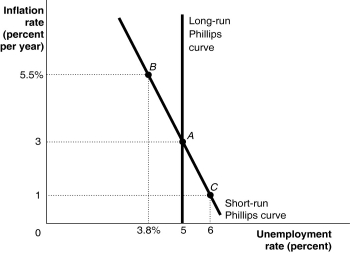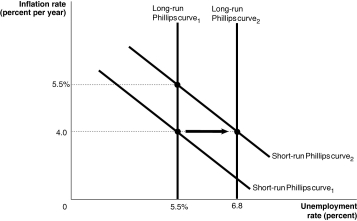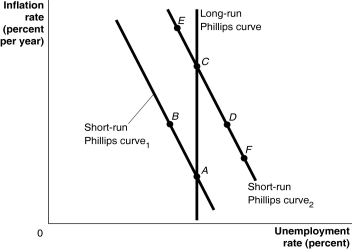A) the inflation rate
B) the unemployment rate
C) the growth rate of real GDP in the economy
D) the natural rate of unemployment
Correct Answer

verified
Correct Answer
verified
Multiple Choice
Where does the short-run Phillips curve intersect the long-run Phillips curve?
A) at the point where the rate of inflation and the unemployment rate are equal
B) at the natural rate of inflation
C) at the point where actual inflation is equal to expected inflation
D) There is no intersection between the short-run and long-run Phillips curves.
Correct Answer

verified
Correct Answer
verified
True/False
In face of a negative supply shock, the Fed may avoid a rise in unemployment only if it is willing to increase the rate of inflation.
Correct Answer

verified
Correct Answer
verified
Multiple Choice
Figure 28-2  -Refer to Figure 28-2. Suppose the economy is at point B. If the Fed increases the money supply so that inflation increases, the economy will ________ in the short run, holding all else constant.
-Refer to Figure 28-2. Suppose the economy is at point B. If the Fed increases the money supply so that inflation increases, the economy will ________ in the short run, holding all else constant.
A) eventually move to point A
B) stay at point B
C) eventually move to point C
D) move to point A and then back to point B
Correct Answer

verified
Correct Answer
verified
Multiple Choice
Parker Hannifin benefitted when the Federal Reserve ________ in 2008. This Fed action would help increase demand for its machinery components, which allowed Parker Hannifin to increase employment and increase prices.
A) drove down interest rates
B) increased the discount rate
C) lowered the required reserve rate
D) implemented a series of open market sales of Treasury bonds
Correct Answer

verified
Correct Answer
verified
Multiple Choice
Figure 28-2  -Refer to Figure 28-2. Suppose the economy is at point A in the figure above. Which of the following is true?
-Refer to Figure 28-2. Suppose the economy is at point A in the figure above. Which of the following is true?
A) The short-run Phillips curve will shift to the right.
B) The short-run Phillips curve will shift to the left.
C) The long-run Phillips curve will shift to the left.
D) Actual inflation and expected inflation are the same.
E) The long-run Phillips curve will shift to the right.
Correct Answer

verified
Correct Answer
verified
True/False
If workers and firms ignore inflation or form their inflation expectations adaptively, expansionary monetary policy will lower unemployment permanently.
Correct Answer

verified
Correct Answer
verified
Multiple Choice
What is the NAIRU?
A) the natural accelerating inflation rate of unemployment
B) the nonaccelerating inflation rate of unemployment
C) the nongovernmental agency of inflationary rate unions
D) the new accrual index of real unemployment
Correct Answer

verified
Correct Answer
verified
Multiple Choice
What is the natural rate of unemployment?
A) the unemployment rate that exists when the economy is at potential GDP
B) the unemployment rate that exists when the economy is at a trough in a business cycle
C) an unemployment rate of 0%
D) any unemployment rate that is above the inflation rate
Correct Answer

verified
Correct Answer
verified
Multiple Choice
Figure 28-3  -Refer to Figure 28-3. The shifts shown in the short-run and long-run Phillips curves between period 1 and period 2 could be explained by
-Refer to Figure 28-3. The shifts shown in the short-run and long-run Phillips curves between period 1 and period 2 could be explained by
A) an increase in the expected inflation rate from 4.0 to 5.5 percent.
B) an increase in the natural rate of unemployment from 5.5 to 6.8 percent.
C) either an increase in expected inflation from 4.0 to 5.5 percent or an increase in the natural rate of unemployment from 5.5 to 6.8 percent.
D) None of the above is correct.
Correct Answer

verified
Correct Answer
verified
Multiple Choice
When inflation is very low, how do workers and firms adjust their expectations of inflation?
A) They rapidly adjust their expectations of inflation upward.
B) They rapidly adjust their expectations of inflation downward.
C) They tend to ignore inflation.
D) They are more aggressive in asking for wage and price increases.
Correct Answer

verified
Correct Answer
verified
Multiple Choice
A study conducted by Alberto Alesina and Lawrence Summers concluded that countries with highly independent central banks had ________ than countries whose central banks had little independence.
A) higher unemployment rates
B) lower unemployment rates
C) higher inflation rates
D) lower inflation rates
Correct Answer

verified
Correct Answer
verified
Multiple Choice
Growth in aggregate demand will
A) cause deflation.
B) increase unemployment.
C) move the economy to a higher point on the short-run Phillips curve.
D) cause the short-run Phillips curve to shift to the left.
Correct Answer

verified
Correct Answer
verified
Multiple Choice
Figure 28-9  -Refer to Figure 28-9. Fed Chairman Paul Volcker's response to the ________ of the late 1970s is depicted in the figure above as a movement from C to D to A.
-Refer to Figure 28-9. Fed Chairman Paul Volcker's response to the ________ of the late 1970s is depicted in the figure above as a movement from C to D to A.
A) deflation
B) high unemployment
C) high inflation
D) appreciation of the dollar
Correct Answer

verified
Correct Answer
verified
Multiple Choice
If actual inflation is less than expected inflation, actual real wages will be ________ expected real wages and unemployment will ________.
A) greater than; rise
B) greater than; fall
C) less than; rise
D) less than; fall
Correct Answer

verified
Correct Answer
verified
Multiple Choice
Figure 28-9  -Refer to Figure 28-9. A supply shock, such as rising oil prices, would be depicted as a movement from
-Refer to Figure 28-9. A supply shock, such as rising oil prices, would be depicted as a movement from
A) A to D to C.
B) C to B to A.
C) C to D to A.
D) C to E to B.
E) A to B to C.
Correct Answer

verified
Correct Answer
verified
Multiple Choice
An increase in the expected inflation rate will
A) shift the short-run Phillips curve to the right.
B) shift the short-run Phillips curve to the left.
C) reduce the inflation rate.
D) reduce the unemployment rate.
Correct Answer

verified
Correct Answer
verified
Showing 241 - 257 of 257
Related Exams